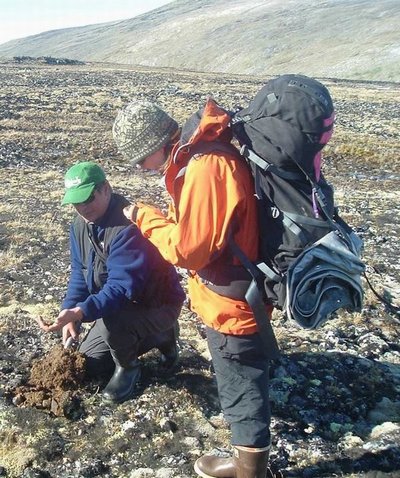December 5, 2005
Warming could free far more carbon from high Arctic soil than earlier thought
SAN FRANCISCO — Scientists studying the effects of carbon on climate warming are very likely underestimating, by a vast amount, how much soil carbon is available in the high Arctic to be released into the atmosphere, new University of Washington research shows.
A three-year study of soils in northwest Greenland found that a key previous study greatly underestimated the organic carbon stored in the soil. That’s because the earlier work generally looked only at the top 10 inches of soil, said Jennifer Horwath, a UW doctoral student in Earth and space sciences.
The earlier work, reported in 1992, estimated nearly 1 billion metric tons of organic carbon was contained in the soil of the polar semidesert, a 623,000-square-mile treeless Arctic region that is 20 percent to 80 percent covered by grasses, shrubs and other small plants. That research also estimated about 17 million metric tons of carbon was sequestered in the soil of the adjacent polar desert, a 525,000-square-mile area where only 10 percent or less of the landscape is plant covered.
Horwath dug substantially deeper, in some instances more than 3 feet down, and found significantly more carbon. She concluded that the polar semidesert contains more than 8.7 billion metric tons of carbon, and the polar desert contains more than 2.1 billion metric tons.
“In the polar semidesert, I found nearly nine times more carbon than was previously reported,” she said. “In the polar desert, I’m finding 125 times more carbon.”
Horwath will present her findings Tuesday in a poster exhibited during the American Geophysical Union’s fall meeting. The work is part of a broader study of carbon content of the water, plants and soil of the high Arctic region led by Jeffrey Welker, a biology professor at the University of Alaska Anchorage. The UW contingent is led by Ronald Sletten, a research associate professor of Earth and space sciences and coauthor of the poster.
Over three years, during thawing from late June to early August, Horwath excavated more than 75 pits on a peninsula near Thule Air Base in Greenland. The peninsula lies between the Greenland Ice Sheet and Baffin Bay. The pits, about three feet square, ranged in depth from 10 inches to nearly 39 inches, with their depth typically limited by bedrock, water table or permafrost. They contained a variety of soil types and features.
The findings are significant because the Arctic is showing greater effects from global climate change than anywhere else on Earth.
“We already know the Arctic climate is warming, and as it warms the depth of the permafrost is lowered. As that happens, more carbon becomes active and can be converted to carbon dioxide, one of the most abundant greenhouse gases in the atmosphere,” Horwath said.
She noted that there is disagreement among scientists on just what the added warmth might mean for the high Arctic. Some say warmer climate will produce greater plant activity to absorb more carbon. Others say the overall carbon absorption is decreasing as the permafrost retreats.
No matter which group is right, she said, it is clearly important for those who run computer models that look at the processes and effects of climate change to have the most accurate numbers possible for the amount of carbon going into the atmosphere.
“The effects of climate change are really hard to predict, and it’s that much harder if you don’t have an accurate picture of what is actually happening now,” Horwath said.
###
For more information, contact Horwath at (206) 543-5255 or horwath@u.washington.edu

